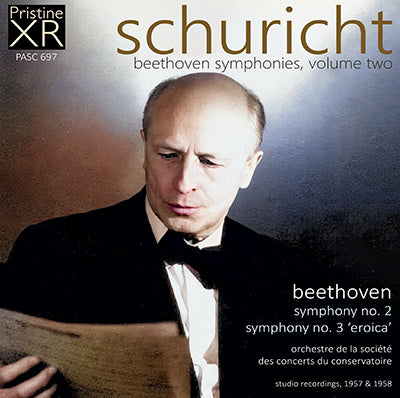
This album is included in the following sets:
This set contains the following albums:
- Producer's Note
- Full Track Listing
- Cover Art
Carl Schuricht’s late-fifties Paris Conservatoire Beethoven symphony
cycle is perhaps one of the more unusual recordings both of its era and,
more generally, of Beethoven cycles. To begin with there is the
question of the recordings themselves.
Made in the Salle Wagram
in Paris between 1957 and 1959 at a time when just about everyone was
embracing the idea of stereo in classical music recordings, the
Schuricht series was made and released in defiant mono. Or was it? For
many years this appeared to be the case – certainly the vinyl releases
at the time were all mono, and often very competitively priced – in the
UK at least.
When EMI reissued the complete cycle in the late
1980s, once again the nine symphonies were released in mono. It was not
until the 21st century that a stereo recording from this set emerged, in
the shape of the Ninth ‘Choral’ Symphony – why this had been
overlooked for so many years is hard to understand. Nevertheless the
rest of the series remains mono or – in the case of these Pristine XR
remasters – with a very pleasing Ambient Stereo ambience.
What
was also unusual was the French orchestra, which to some contemporary
ears outside of the country sounded all wrong: for some it was the
playing style, for others the sound of some rather unique instruments in
the brass and woodwind were off-putting. But in the fullness of time
opinions have been revised and some have come around to the view that
this is a very special Beethoven cycle indeed:
“My
immediate impression was that I had never heard Beethoven conducted in
quite this way. That is not the same as saying I had never heard
Beethoven played this way. By certain string quartets, for example. I
was reminded of Serkin playing the piano sonatas, even more, perhaps, of
late Backhaus. The first symphony immediately created an impression of
gut conviction and great vitality. As with late Backhaus, technical
perfection is not an essential, phrasing can be a bit rough and
breathless, but you get a sense of contact with the music that you more
often get from hands-on performers than from conductors whose vision has
to be realised by others: namely the orchestra. This generally
translates into brisk, spinning tempi that are not driven, or goaded
onward, by a conductor with a whip, but have a vitality that seems to
arise from the music. In the second movement of this same symphony there
is a warm songfulness rather than an attempt to wrest a prayer for
humanity from every phrase. It is here, too, that the French woodwind
are at their most piquant.
I must record a curious sensation over
this. While it is true that the Historically Informed brigade would run
a mile from such vibrato, modern performances on period-style
instruments have rediscovered a factor which was still available in
Paris in the 1950s. Each instrument has its own personality, makes its
own contribution to the argument, instead of being blended so that the
wind band might as well be a harmonium. With the wind forwardly balanced
into the bargain, these performances contain elements that were
scarcely heard again until the HIP movement got going two decades later.
This
sense of vital contact with the music crescendos through the first
three symphonies. The “Eroica” slow movement is an interesting case.
Schuricht starts out at a fairly flowing, but expressive tempo. Most
conductors start slower, but have to move forward later. Schuricht holds
his tempo, but not in the sense of dogmatically ploughing on
regardless. He simply doesn’t seem to find it necessary to make any
adjustment, for his tempo fits every part of the movement beautifully.
The proof of this is heard as the initial march theme returns after the
climax and sails in without the conductor having to put on the brakes.
The final disintegration has rarely been so moving – it emerges so
inevitably from what came before. In spite of a not very slow initial
tempo this is one of the longer versions on record: at 15:40 it is
exceeded by Toscanini’s 16:06 in 1939 but is expansive compared with
Klemperer’s 14:43 in 1956 – and no, I haven’t got these the wrong way
round…
…The time has now come to take it seriously. Heaven forbid
that any critic should recommend a “best version” of such multifarious
works, or even a “best version” of each single symphony. We can try to
distinguish between the ones that count and those that don’t. This cycle
counts. It explores avenues of Beethoven interpretation, areas of
Beethovenian truth, not touched upon elsewhere.” - Christopher Howell, MusicWeb International, 2013
Andrew Rose
SCHURICHT Beethoven Symphonies Volume Two
BEETHOVEN Symphony No. 2 in D major, Op. 36
1. 1st mvt. - Adagio molto - Allegro con brio (10:00)
2. 2nd mvt. - Larghetto (12:06)
3.3rd mvt. - Scherzo. Allegro - Trio (3:21)
4. 4th mvt. - Allegro molto (6:57)
Recorded 26 & 27 September, 1958
BEETHOVEN Symphony No. 3 in E flat major, Op. 55, 'Eroica'
5. 1st mvt. - Allegro con brio (14:15)
6. 2nd mvt. - Marcia funebre. Adagio assai (15:46)
7. 3rd mvt. - Scherzo. Allegro vivace - Trio (5:36)
8. 4th mvt. - Finale. Allegro molto (11:09)
Recorded 18, 20, 23 December, 1957
Orchestre de la Société des Concerts du Conservatoire
conducted by Carl Schuricht
XR Remastered by Andrew Rose
Cover artwork based on a photograph of Carl Schuricht
Recorded at Salle Wagram, Paris
Producers:
Victor Olof (Symphony 2)
Norbert Gamsohn (Symphony 3)
Engineer: Paul Vavasseur
Total duration: 79:10

